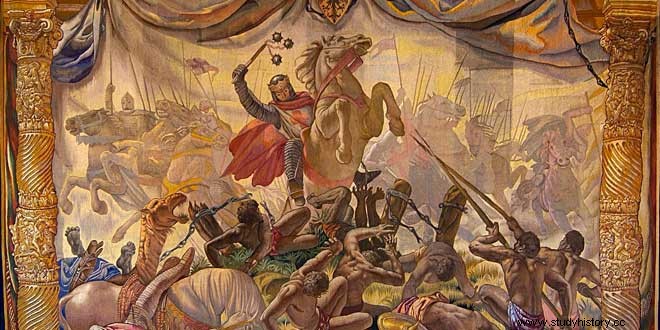Alfonso VIII (the Noble and the Navas) he was king of Castile. He was born in 1155, who was the son of Sancho III, whom he succeeded in 1158, under the tutelage of Gutiérrez de Castro; but the Lara managed to take away his guardianship, which led to a civil war between both sides; the King of Navarre, Sancho IV, took advantage of the occasion to appropriate several squares in La Rioja.
The king was declared of legal age in the Courts of Burgos in 1170. He made an alliance with Alfonso II of Aragon (who married, in 1174, Sancha, Alfonso VIII's aunt) and, with his help, recovered, in 1175 , the squares that the King of Navarre had taken from him, and also conquered the city of Cuenca from the Almohads in 1177, for which he annulled the fief that Castile had over Aragon, as a reward to Alfonso II for his help. Alfonso VIII, continuing the fight against the Almohads, took Sietefila in 1182, Alarcón in 1184, Infíesta in 1186, Reyna in 1187, Magazuela, Baños and Calasparra in 1189, and reached Algeciras in 1194; from there he sent a letter of challenge to the Almohad emir al-Mansur, who was in the Maghreb; he responded furiously on the back of the same letter saying that he was going to come and undo it. Indeed, the Almohad appeared in al-Andalus with a large army, and defeated Alfonso VIII at the battle of Alarcos on July 19, 1195 .
Later, Alfonso VIII led the war against León and Navarra for not having come to his aid in time. Pedro II of Aragón helped the Castilian, and everything ended up marrying Berenguela (daughter of Alfonso VIII) with Alfonso IX of León in 1198. Then, Alfonso VIII led the war against the Navarrese Sancho VII; he went to the Maghreb to ask al-Mansur for help; meanwhile, in the year 1200, the three Basque provinces, which were three manors, separated from the Navarrese king and came to belong to Castile:Guipúzcoa proclaimed Alfonso VIII king on that date, while Álava and Vizcaya, still belonging since then to Castile, they continued to be lordships until 1332 and 1379 respectively, when they became part of Castile. In 1211, Alfonso VIII returned against the Almohades and he arrived to Játiva accompanied by his son Fernando, who, after taking Trujillo and Montánchez, died that same year in Madrid upon returning from that campaign. Then the Almohad emir Al-Nasir (1199-1213) came from the Maghreb with a large army. Alfonso VIII asked Pope Innocent III (1198-1216) to preach a crusade against the Muslims; the Pope not only preached the crusade, but also granted a plenary indulgence to all those who came to the Iberian Peninsula to fight against the infidel Muslims, enemies of the Catholic faith. Then the Battle of Las Navas de Tolosa took place in 1212 (as noted when speaking of the emir Al-Nasir, 1199-1213).
As a consequence of this great victory over the Muslims, the Catholics instituted the feast of the Exaltation of the Cross. The King of Castile repopulated Vilches, Baños, Tolosa and Ferrat and took Baeza in 1212, Dueñas and Alcaraz in 1213; but the Almohads launched a counteroffensive and took possession of Baeza; As Alfonso VIII could not recover it, due to a time of famine, he signed a truce with Al-Nasir. Then Alfonso VIII died on October 5, 1214 in Gutiérrez Muñoz (Ávila) . Apart from his war activity, he founded the University of Palencia and the monastery of Las Huelgas de Burgos, where he was buried, as well as his wife, Leonor, who died shortly after him; they had married in 1170; she was the daughter of King Henry II of England and Eleanor of Aquitaine. Alfonso VIII had the following children from her:Berenguela (mother of Fernando III), Fernando (died in 1211), Enrique (who succeeded him), Urraca (queen of Portugal), Blanca (queen of France, mother of Luis IX) and Leonor (first wife of King Jaime I of Aragon).

